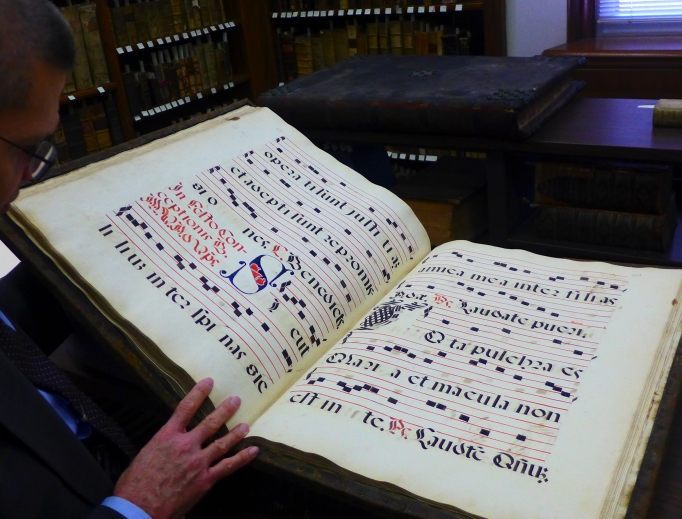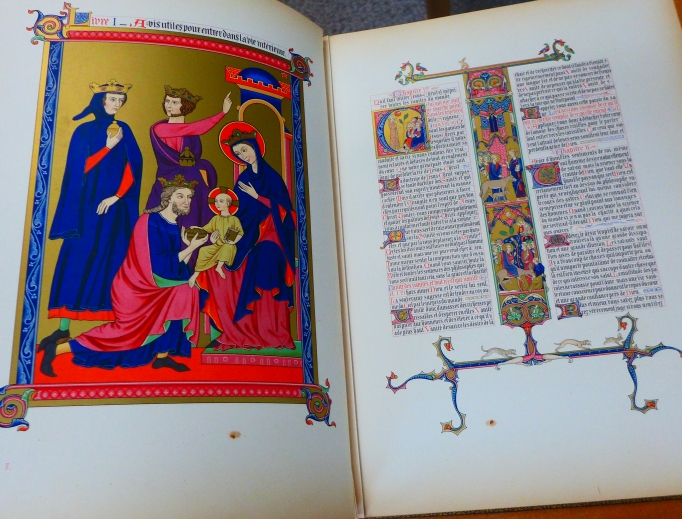Reading History: Seminary Library Hosts Ancient Catholic Tomes
St. Joseph’s Seminary and College bibliotheca, with 105,000 print volumes, has been serving and educating the faithful for 122 years.

Approximately 27 miles north of Midtown Manhattan, a library has been serving and educating the faithful for 122 years.
Located at a center of Catholic thought and culture, peacefully sitting on 40 quiet acres atop Valentine Hill in Yonkers, New York, St. Joseph’s Seminary and College — founded in 1896 — is now a major institution for priestly formation for the Archdiocese of New York as well as the Diocese of Brooklyn and the Diocese of Rockville Centre, New York. The heart, soul and primary classroom is the main chapel that has been visited by two sitting popes, St. John Paul II and Benedict XVI. Supplementing and enhancing the spiritual insights and instincts of the student body is the rich repository of books and information known as the Corrigan Memorial Library.
I visited specifically to explore the Major Edward J. Bowes Rare Book Room and to see firsthand some of the more interesting holdings. I met with James Monti, author of five books, including A Sense of the Sacred: Roman Catholic Worship in the Middle Ages, who also works as a part-time researcher and clerk at the Corrigan.
My host first led me to the papal throne used by John Paul II when he visited the seminary in 1995. The chair can be considered a second-class relic because it was used by the saint. We prayed before it and then made our way to the Rare Book Room, which holds 700-plus titles, out of 105,000 print volumes in the entire library.
The criteria for inclusion in this reserved space are a book’s antiquity (generally, books published before 1800), its rarity and its historical or ecclesiastical importance. Monti proved to be the perfect host for the day. With a keen appreciation for books and study and a love for Holy Mother Church, he had pulled some of the more interesting books from the collection and presented them to me.
“There are so many books in this collection that I love, and I’m continuing to discover more,” he said, “but if I had to pick one in particular as my personal favorite, it would be the 1506-1508 glossed Bible of John Froben, the Textus Biblie cum glossa ordinaria that has the scriptural commentaries of Nicholas of Lyra. This Bible connects me in a very special way to the world of my favorite saint, Thomas More.
“When I was reading More’s life for my book about him, repeatedly I encountered references to his use of Nicholas of Lyra’s commentaries. As a physical artifact dating from More’s lifetime and perhaps identical to, or at least very similar to, the edition of the glossed Bible that he and his family would have read, this Bible makes me feel closer to the saint — for, to me, it is in a way an embodiment of his piety, his scholarship and his family life.”
The oldest item in the room dates back to 1407 — it still bears the chain to which it was attached centuries ago to keep it from being stolen, since it was deemed a valuable asset. Another artifact that I never expected to see was a 19th-century Ethiopian leather pouch containing a prayer book.
Books, especially old books that were made on the cusp of the advent of the printing press and in the years following the introduction of Johann Gutenberg’s movable-type machine around 1450, tell more than one story. There is the text itself, and then there is the construction of the book. Books with wooden bindings and clasps; huge books that could be seen by the choir from a distance; hybrid books that were printed and handwritten; books manufactured by famous early printers such as Anton Koburger and John Froben; and early works of Erasmus that influenced Western civilization are such marvels to behold.
On an inside page of an 18th-century antiphonary, the Carmelite friars of San Martino in Bologna, Italy, recount a vision seen by their brother friars 300 years earlier in 1488.

While those 15th-century friars were singing the Salve Regina, Our Lady reportedly appeared and said, “Chant devoutly (my) children; I will show you my Son, both now and in the future.” This incident was so revered and so treasured by the community that it was remembered and written down hundreds of years later. Now, 530 years after that event, it is once again considered, connecting us to our rich Catholic heritage.
Certainly one book that stimulates curiosity and wonder is the largest book in the collection, an antiphonary used during the Easter Octave, dating from perhaps the late 16th century. The sheer size of it is impressive. Too big for the early printing presses, the book was done by hand and resulted in an extra-large book that could be seen by the monks from their choir stalls. I can imagine one very strong monk, or perhaps two, handling the oversized book, lifting it and arranging it on the stand, then turning the pages as the monks chanted during those early spring evenings hundreds of years ago.
The first page of this Easter antiphonary begins with the chant Surrexit Dominus vere, alleluia (“The Lord has truly risen, alleluia”). This line, so beautiful, is at once a statement of fact and a hymn of praise, representing an unbroken line of faith and exclamation from that first Easter Sunday until the present time.


Franciscan Brother Gabriel Monahan, of the Franciscan Friars of the Renewal, is studying Scripture at the seminary. He says the relationship between study, faith and action is key: “Taking these few years to study is a privileged space of tapping into the richness of the Catholic faith.”
He says Mother Mary reminds him, as a seminarian, “that it’s not about the grades or the style of my papers, but theology is a matter of treasuring these truths and pondering over them in my heart. Faith is the story of falling in love with the Person of Jesus. And you can’t love someone you don’t know. I suppose the time I spend here studying at St. Joseph’s is just a way of getting to know the Person with whom I want to fall in love with.”
Brother Gabriel, who began his studies here in 2015, appreciates the various levels of support and intellectual nourishment that studying at the seminary provides.
“In the silence of the chapel, my heart is able to quiet down and try to be receptive to an awareness of God’s presence,” he says. “Likewise, in the quiet of the library, my mind is able to quiet down a bit and is much clearer in order to think and digest what I have been reading or writing about.”
Jobin Thomas is studying for the Syro-Malankara Catholic Eparchy of the U.S.A. and Canada and is in his third year of study at St. Joseph’s Seminary. For him, “To study our faith allows us to grow closer to God and to our Blessed Mother. When we have a better understanding of what and why we believe what the Catholic Church teaches, it is then and only then that we can transmit this to others. As someone studying to become a priest, I realize that communication of these truths in an easy-to-understand language is of the utmost necessity.”
“The library is a beautiful resource and gift that brings faith and intellect together, both by the books in its collection and through the wonderful staff who go above and beyond to help the student,” said Anna Paolicelli, a youth minister for Our Lady of Lebanon Maronite Cathedral in Brooklyn who is in her first year of study for her master’s degree in theology. “St. Joseph’s is like a family and a home — the library is certainly proof of that.”
James Carmody writes from Stratford, Connecticut.
INFORMATION
The seminary is located at 201 Seminary Ave., Yonkers NY, 10704.
The library website is Dunwoodie.edu/library.
Contact Connor Flatz, the director of the Corrigan, at [email protected] for more information.

















